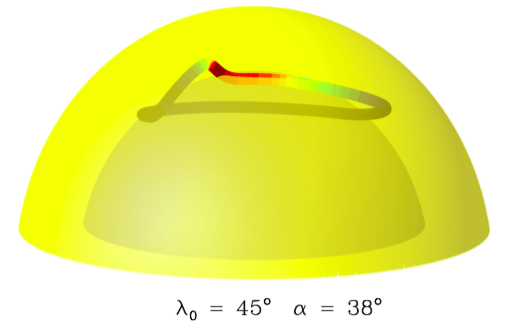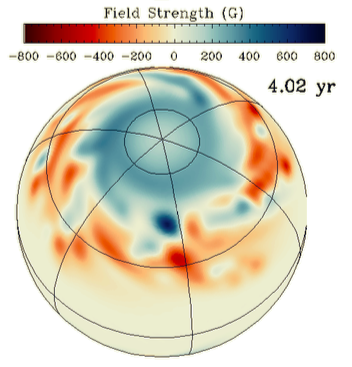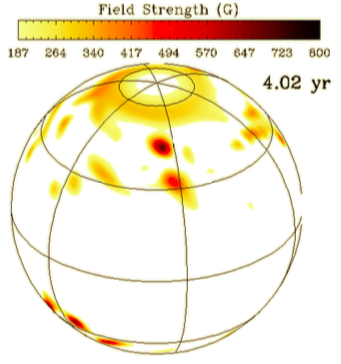Stellar magnetic activity
Listed below are highlights from studies that I led or contributed (sorted by recency)
Modelling magnetic activity and starspot distributions
on solar-type stars
How did the Sun look like billions of years ago, when it
was much younger? We know that younger G-K-type stars show
magnetic features more towards higher latitudes and even
at their poles, whereas the Sun has a very low average
latitude of activity. So far, the latitudinal distribution
of activity along with surface flux transport has not been
systematically modelled. By using theoretical models and
numerical simulations of magnetic flux emergence and
global surface transport, we attempted the first such
systematic models of Sun-like stars with gradually larger
rotation rates, from the solar rate up to eight times
faster and more active stars. We determined a criterion
for starspot coverage based on the observed sunspot
coverage, and used an empirical rotation-activity
relationship to predict surface distributions and
coverages of starspots. The modelling platform for global
magnetic activity patterns we developed will be used to
synthesise photometric light curves for comparison and a
better understanding of stellar light curves, which are
collected in large-scale surveys dedicated to exoplanet
hunting, such as Kepler and TESS. The figure shows
for a Sun-like star rotating 8 times faster and 8 times
more active than the Sun (from left to right) the
emergence of a magnetic flux tube with a high tilt angle
of 38 degrees; the magnetic field pattern and the
corresponding estimated starspot pattern from a snapshot
near the maximum phase of its activity cycle. References
Işık, E., Solanki, S.K., Krivova, N.A., Shapiro, S.K. 2018 Astron. & Astrophys. 620, A177Işık, E., Solanki, S.K., Krivova, N.A., Shapiro, S.K. 2018 Proc. of 20th Workshop on Cool Stars, Stell. Sys., & the Sun
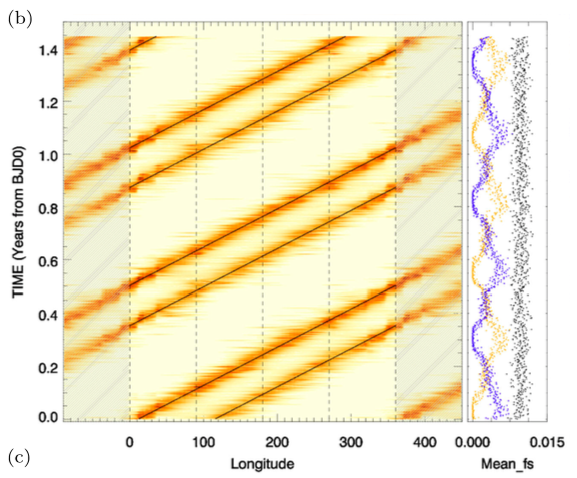
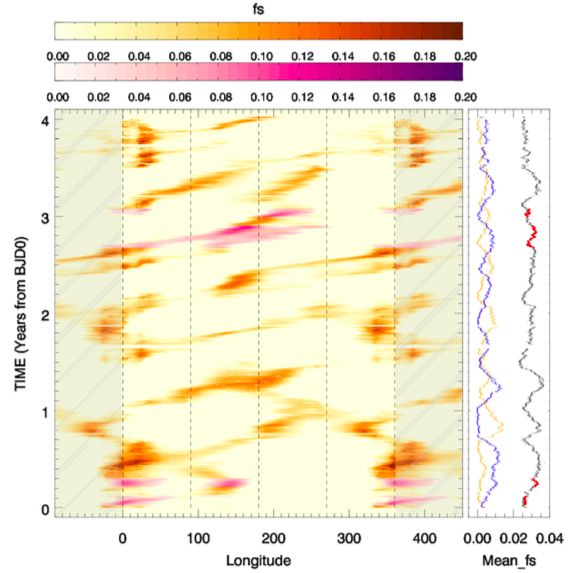
Revealing starspot activity and differential rotation on a K1 sub-giant star
We carried out a detailed analysis of photometric data from the Kepler space telescope of an eclipsing close binary system, KIC 11560447. By designing numerical simulations of starspot distributions with the same stellar parameters, we demonstrated that it was possible to track the phase motion of starspots (in longitude) for up to 3 distinct spot clusters, amid a background of randomly emerging small-scale spots (see the figure on the left, for 2 input clusters). Then we inverted 2800 light curves of the system, to obtain a time-longitude map of the relative spot occupancy, which exhibited recurrent emergence of spot complexes, which drift with different phase speeds (see the figure to the right). Perhaps not surprisingly, both the simulation and observations showed the so-called flip-flop phenomenon for the hemispheric averages of spot occupancy (see right-hand panels on each figure). We used this information to obtain the relative rotation rates of these spots, which are presumably at different latitudes. We found a solar-like differential rotation whose rate is consistent with what we found by measuring slopes of drifting patterns in the above diagram.References
Özavcı, İ., Şenavcı, H.V., Işık, E., Hussain, G.A.J., O'Neal, D., Yılmaz, M., Selam, S.O. 2018 Mon. Not. Roy. Astron. Soc., 474, 5534Işık, E., Özavcı, İ., Şenavcı, H.V., Hussain, G.A.J., O'Neal, D., Yılmaz, M., Selam, S.O. 2018 IAU Symp. 340, Long-term Datasets for the Understanding of Solar and Stellar Magnetic Cycles, Cambridge U. Press, in press (see poster or arXiv preprint for a 2-page summary)
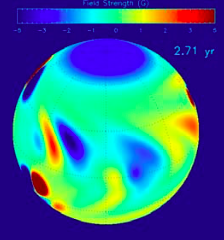
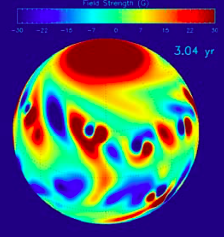

A combined model for magnetic field generation and
transport in cool stars
In my PhD
thesis (2008), I have developed a unified model that
considers physical processes for the generation,
emergence, and surface transport of magnetic flux in the
Sun and other cool stars. The ‘other’ cool stars that I
first considered were Sun-like stars which rotate faster
than the Sun, the so-called ‘young suns’ (for more
information, see here).
The figure shows snapshot magnetic field distributions on
the surface of a Sun-like star, rotating at the solar
rate, with a rotation period of 9 days, and 2 days. The
saturation levels of the color scale representing the
field strength is 5 G, 30 G, and 75 G from slow- to
fast-rotating cases. The result I find the most
interesting in this work is the case of a 'flat-activity'
star showing no clear cycle signal, despite having a
periodic dynamo in its interior (the middle panel above).
We applied the model to two additional stellar models that are interesting to observers of stellar magnetic activity: a K0V star with 2-day rotation period, and K1IV type subgiant with 2.8-day rotation period, similar to HR 1099.
References
Işık, E., Schmitt, D., Schüssler, M., 2007, Astron. Nachr., 328, 1111 [First results for Sun-like stars]Işık, E., Schmitt, D., Schüssler, M., 2011, Astron. & Astrophys., 528, A135 [Detailed description of the combined model and application to G and K stars.]
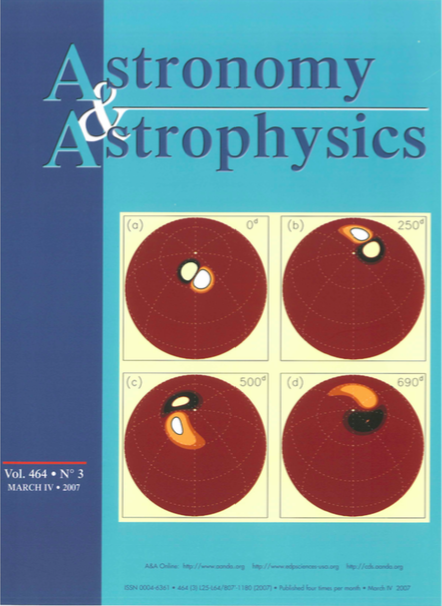
Magnetic flux transport on active cool stars: lifetimes of starspots
I carried out numerical investigations concerning the effects of large-scale surface flows on the lifetimes and structure of starspots. The image to the left shows the simulated evolution of a bipolar magnetic region (BMR) of the same fractional area of a large solar BMR, on a subgiant star of about 3 times the solar radius, and having the observed differential rotation of the active subgiant component of HR 1099. The structure emerges at 70 degrees latitude and lives for about two years. You may have a look on how the simulations give an idea about the formation/maintenance of a polar spot on a dwarf and on a subgiant star, when there is a supply of high-latitude flux due to random emergence of six tilted bipolar regions. Collaborators: M. Schüssler and S. K. Solanki.For another key result of the study, see here.
